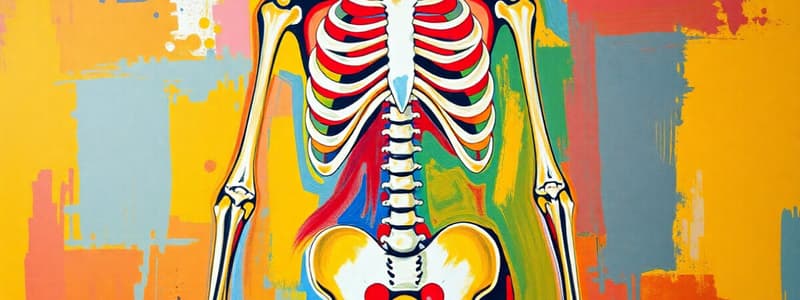Podcast
Questions and Answers
What is the primary function of the epiphyseal cartilage plate in long bones?
What is the primary function of the epiphyseal cartilage plate in long bones?
- To serve as the site of bone ossification when growth is complete
- To provide structural support to the bone
- To act as the primary site for bone marrow production
- To connect the diaphysis and epiphysis (correct)
Which type of bone forms the outer hard layer of bones?
Which type of bone forms the outer hard layer of bones?
- Compact bone (correct)
- Irregular bone
- Cancellous bone
- Pneumatic bone
Which type of bone is a good example of a flat bone?
Which type of bone is a good example of a flat bone?
- Femur
- Vertebrae
- Scapula (correct)
- Phalanges
What describes the medullary cavity within the shaft of long bones?
What describes the medullary cavity within the shaft of long bones?
Which type of bone develops in dense membranes?
Which type of bone develops in dense membranes?
What are the primary divisions of the human skeleton?
What are the primary divisions of the human skeleton?
How many vertebrae are present in the cervical region of the vertebral column?
How many vertebrae are present in the cervical region of the vertebral column?
Which bone is part of the axial skeleton?
Which bone is part of the axial skeleton?
What forms the pelvic girdle?
What forms the pelvic girdle?
Which structure is formed by the union of the sacral vertebrae?
Which structure is formed by the union of the sacral vertebrae?
What is the number of bones in the proximal segment of the upper limb?
What is the number of bones in the proximal segment of the upper limb?
Which pair of bones is found in the intermediate segment of the upper limb?
Which pair of bones is found in the intermediate segment of the upper limb?
Which of the following components is part of the appendicular skeleton?
Which of the following components is part of the appendicular skeleton?
Flashcards are hidden until you start studying
Study Notes
Classification of the Skeletal System
- The human skeletal system is divided into two parts: axial and appendicular skeletons.
- The axial skeleton includes the skull, vertebral column, ribs, and sternum.
- The appendicular skeleton includes the bones of the upper limb, lower limb, pectoral girdle, and pelvic girdle.
- The skull, including the mandible, forms the skeleton of the head.
- The skull without the mandible is called the cranium.
The Axial Skeleton
- The vertebral column is composed of a series of vertebrae that articulate with each other through fibrocartilaginous intervertebral discs.
- The vertebral column is divided into five regions:
- Cervical (7 vertebrae)
- Thoracic (12 vertebrae)
- Lumbar (5 vertebrae)
- Sacral (5 vertebrae)
- Coccygeal (4 vertebrae)
- The thoracic cage is formed by the thoracic vertebrae, ribs, costal cartilages, and sternum.
- The sacral vertebrae fuse to form a single triangular bone called the sacrum.
- The pelvis is formed by the sacrum and two hip bones.
The Appendicular Skeleton
- The upper limb (UL) and lower limb (LL) skeletons are similar in structure.
- Each consists of three segments: proximal, intermediate, and distal.
- The proximal segment of each limb consists of one bone:
- UL: Humerus
- LL: Femur
- The intermediate segment of each limb consists of two bones:
- UL: Radius and Ulna
- LL: Tibia and Fibula
- The distal segment of each limb consists of three sets of bones:
- Small bones: Carpal bones in the hand, Tarsal bones in the foot
- Five elongated bones: Metacarpals in the hand, Metatarsals in the foot
- Phalangeal bones: Three in each finger or toe, except for the thumb and big toe, which have two.
The Pectoral and Pelvic Girdles
- The pectoral girdle (shoulder girdle) is composed of the scapula and clavicle.
- The pectoral girdle articulates with the axial skeleton anteriorly at the sternoclavicular joint.
- The pelvic girdle is composed of the two hip bones.
- The pelvic girdle articulates with the axial skeleton posteriorly at the sacroiliac joint.
Types of Bones
- Bones can be classified according to their structure, shape, and development.
Structure
- Compact bone: Forms the outer hard layer.
- Cancellous bone (Spongy): Forms the inner delicate layer.
Shape
- Long bones: E.g., bones in the proximal and intermediate segments of the limbs
- Short bones: E.g., carpal and tarsal bones
- Flat bones: E.g., scapula and bones of the skull cap
- Irregular bones: E.g., vertebrae and the bones of the skull base
- Pneumatic bones: E.g., skull bones containing air-filled spaces (sinuses)
Development
- Membranous bones: Developed in dense membranes
- Cartilaginous bones: Developed in preformed cartilages
Parts of a Long Bone
- Long bones have two ends and a shaft.
- Each end is called an epiphysis.
- The shaft is called the diaphysis.
- The growing part between the epiphysis and diaphysis is called the epiphyseal cartilage plate.
- The epiphyseal cartilage plate is the site of bone length increase and the site of ossification when the bone length is complete.
- The region of the shaft close to the epiphyseal cartilage plate is called the metaphysis.
- The shaft is composed of compact bone and contains a cavity called the medullary cavity filled with bone marrow.
- The shaft is covered with a fibrous membrane called the periosteum.
- The epiphysis is composed of cancellous bone and covered with a layer of hyaline cartilage.
Studying That Suits You
Use AI to generate personalized quizzes and flashcards to suit your learning preferences.




